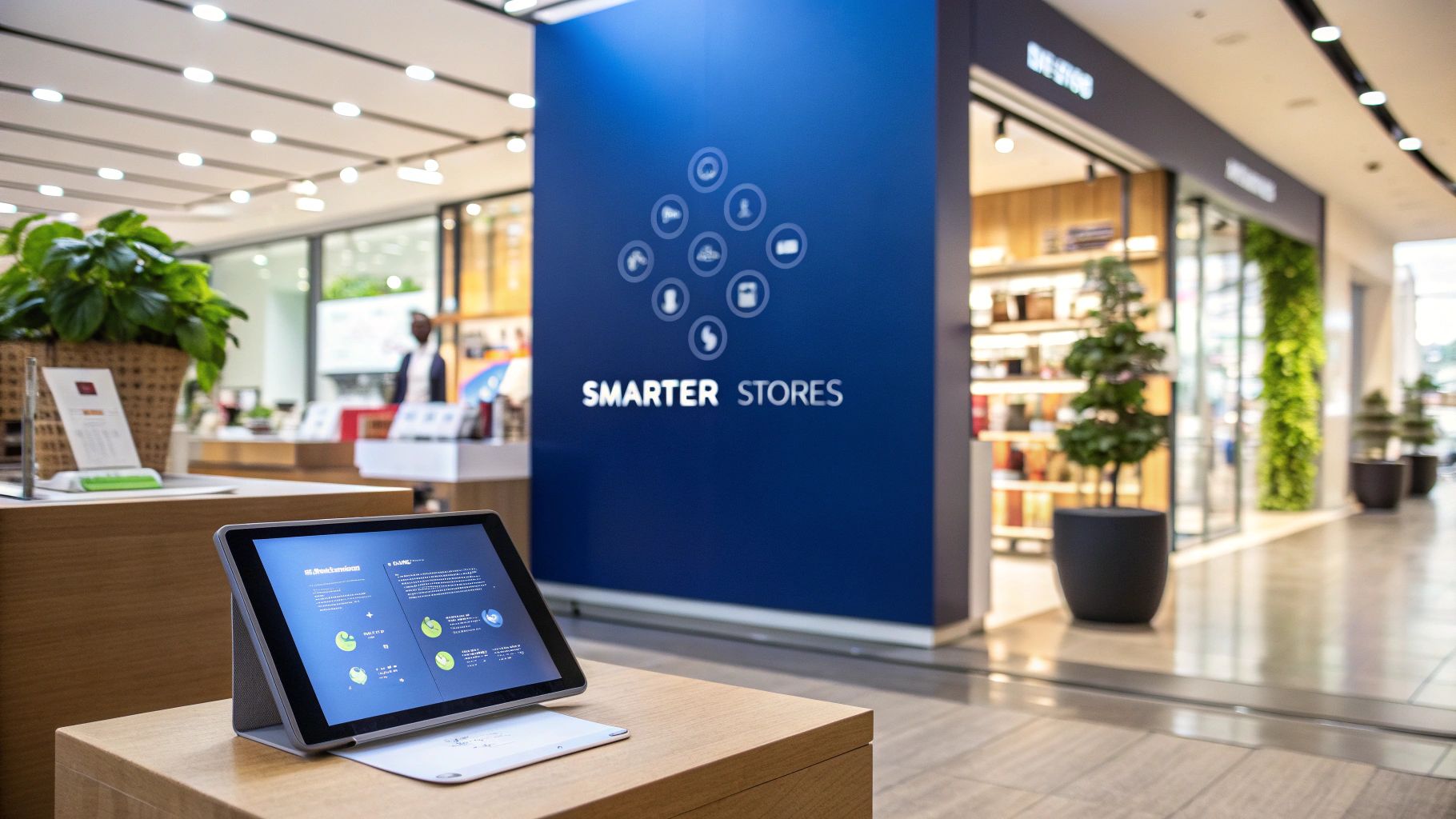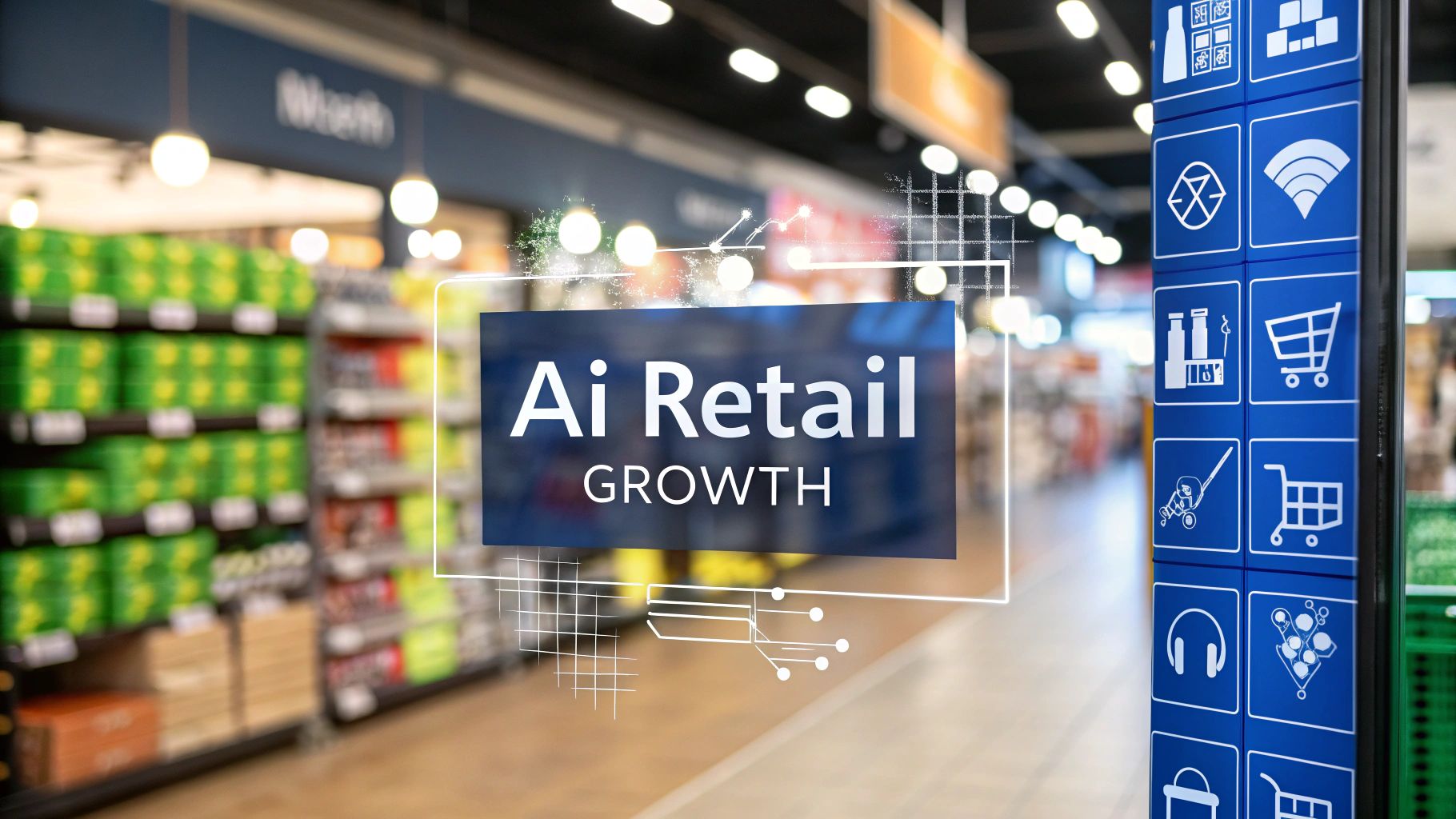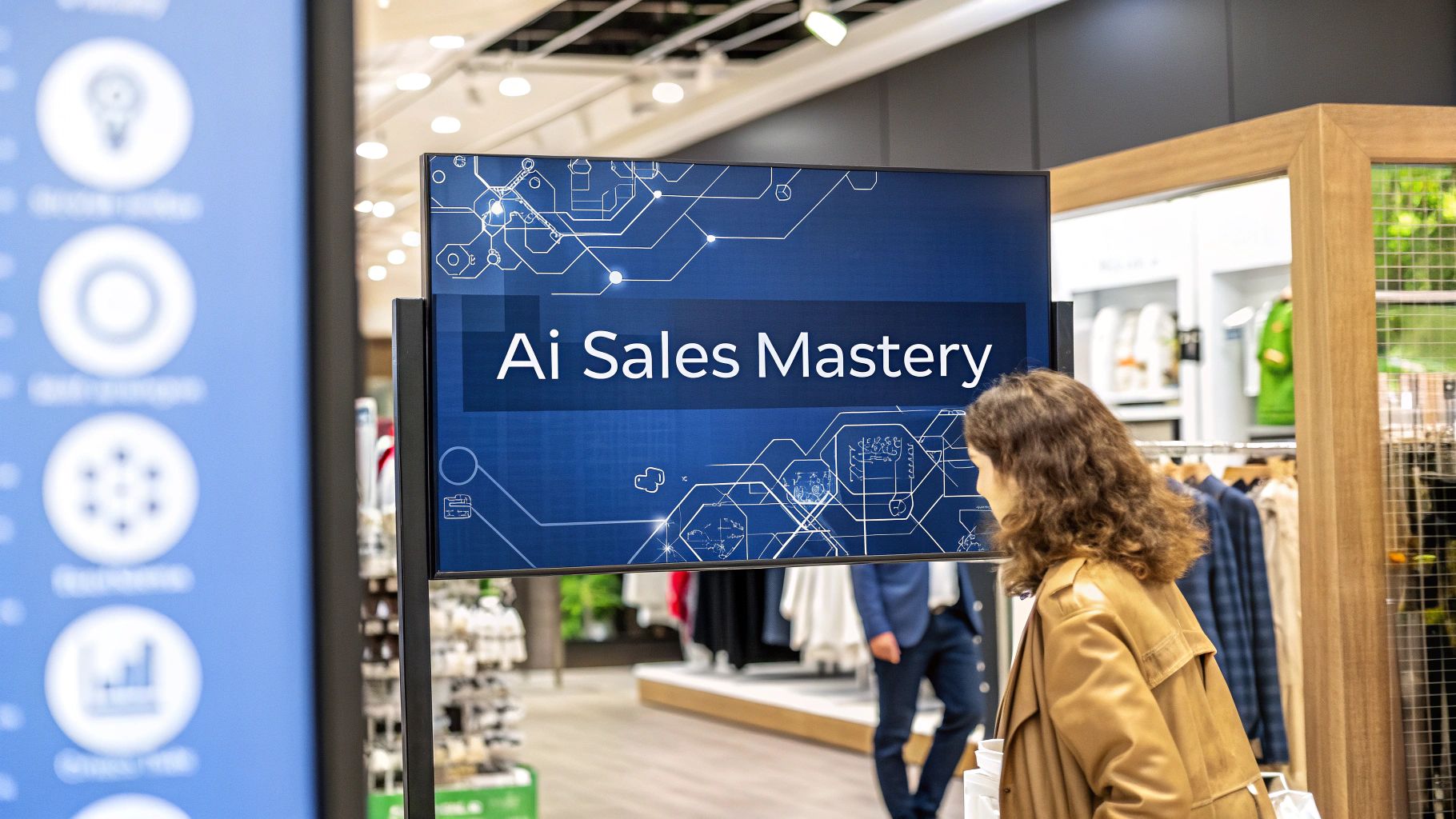Picture your online store having a personal shopper for every single visitor. This shopper knows their style, anticipates their needs, and guides them straight to the perfect purchase. That’s the kind of power AI in ecommerce brings to the table for Small and Medium-sized Enterprises (SMEs), turning a simple digital catalogue into an intelligent, responsive shopping experience. For Canadian SMEs, this technology is no longer a far-off idea but a real tool for growth.
Your New Competitive Edge: AI for Ecommerce
Artificial intelligence is fundamentally changing how online stores work. Instead of treating every customer the same, AI lets you create unique, one-on-one shopping journeys that make visitors feel seen and understood. Think of it as the digital version of a friendly shopkeeper who remembers what you like and always has a great suggestion ready.
This shift is a game-changer for small and medium-sized enterprises (SMEs) trying to compete in a crowded market. AI tools can handle tedious tasks automatically, give you deep insights into how your customers behave, and ultimately help you make smarter business decisions, all without needing a huge team or a massive budget. The whole point is to move beyond a static website and build a dynamic system that actually learns and improves with every customer interaction.
Why AI Matters Now More Than Ever for SMEs
AI isn't just a passing trend; it's a major business shift that's reshaping ecommerce and operations across Canada. According to a recent government survey, 12.2% of Canadian businesses reported using AI in the last year to produce goods or deliver services. That's double the 6.1% adoption rate from the year before. You can explore more on this trend in the AI adoption insights from Statistics Canada.
This explosive growth sends a clear message: businesses that get on board with AI are gaining a serious advantage. For an SME, that can be the difference between just getting by and truly standing out.
AI turns your complex data into your most valuable asset. It gives you the power to boost sales, streamline operations, and build real customer loyalty. It essentially levels the playing field, giving smaller businesses the tools to offer the kind of personalized service that used to be only for the retail giants.
What This Guide Will Cover
This guide is built to break down what AI in ecommerce really means for Canadian SME owners. We're going to dive into practical, real-world applications you can actually use to see a difference. We’ll be focusing on:
-
Creating Unforgettable Shopping Experiences: Using AI to personalize every touchpoint of the customer journey.
-
Streamlining Your Business Operations: Automating tricky things like inventory, logistics, and fraud detection.
-
Driving Smarter Marketing and Sales: Figuring out the best pricing, ads, and customer targeting.
By the end, you’ll have a clear roadmap for making AI work for your business, helping you not just survive but thrive in today's digital marketplace.
How AI Creates Unforgettable Shopping Experiences

The real magic of AI in ecommerce is its ability to make every single customer feel seen and understood. It’s a complete shift away from the old one-size-fits-all model, allowing businesses to create shopping journeys that feel genuinely personal. This kind of individual attention used to be something you could only get in a physical store, but AI brings that same feeling right to your digital doorstep.
Think of it like having the most intuitive sales assistant on your team, one who remembers every customer's tastes, gets what they're looking for, and can even guess what they’ll want next. For small and mid-sized businesses, this is a huge deal. It’s a way to build real customer loyalty and boost sales without needing a massive support team.
Predictive Product Recommendations
Let's be honest, old-school recommendation engines weren't always that helpful. They’d just show you what was popular or what other people bought. AI-powered recommendations, on the other hand, are like a personal stylist who knows your taste inside and out.
These smart systems dig deep into a customer's behaviour and see what they've bought, what they've clicked on, the search terms they've used, even how they move their mouse around the site. By piecing together all these little clues, the AI builds a unique profile for each shopper and starts spotting patterns. This lets it predict what someone will love, sometimes before they even realise it themselves. It's a powerful tool; some reports show that retailers using personalization well can see a revenue lift of up to 40%.
For instance, imagine a customer at a Toronto-based clothing shop buys a winter coat. A basic system might suggest a hat. But an AI system might notice their browsing history is full of outdoor gear and suggest thermal base layers and waterproof gloves – a far more relevant and helpful recommendation. Your store suddenly becomes a trusted guide, not just a catalogue.
By analyzing individual behaviour, AI doesn’t just show customers more products; it shows them the right products at the right time. This proactive approach helps reduce abandoned carts and keeps shoppers engaged.
Smarter And More Intuitive Search
Nothing kills a sale faster than a clunky search bar. If shoppers can't find what they're looking for, they're gone in a flash. AI turns your store’s search function from a rigid keyword-matcher into a smart discovery tool that actually understands what people mean.
AI-powered search gets the intent behind the words, not just the words themselves. It can handle spelling mistakes, figure out synonyms, and even understand more natural, conversational questions.
This technology is also opening up completely new ways for people to shop:
-
Visual Search: This is a game-changer. A customer can upload a photo of a product they like, maybe from Instagram or something they saw in real life, and instantly find similar items in your store. If they spot a cool backpack on the street, they can snap a picture and see if you sell anything like it.
-
Voice Search: With everyone using smart speakers and phone assistants, shopping by voice is becoming more common. AI-driven search allows customers to just ask, "Show me blue women's running shoes in a size eight," and get spot-on results right away.
By making the search process feel more human and effortless, you remove a major point of friction and make it that much easier for customers to find and buy what they want.
24/7 Support With AI Chatbots
For most small businesses, offering round-the-clock customer service just isn't feasible. This is where AI-powered chatbots come in. They provide instant, helpful support 24/7, handling common queries without needing a human to step in.
Today's chatbots are incredibly capable. They can do everything from answering basic questions like "Where's my order?" to actually guiding a customer through a purchase. This frees up your human team to tackle the more complex problems that truly need their expertise.
Picture a local gift shop in Vancouver. A customer is on the website late at night, scrambling to find a last-minute birthday gift. The chatbot can ask a few guiding questions like, "What are her hobbies?" or "What's your budget?", and then pull together a curated list of gift ideas from the store's inventory. This not only saves the sale but creates a genuinely helpful and memorable interaction. It’s no surprise that chatbots now handle up to 70% of online customer conversations. Providing this level of service at any hour is a perfect example of how AI is redefining the shopping experience in retail.
Making Your Business Run Smoother with AI Automation
Beyond creating a slick storefront experience, AI in ecommerce is a massive help for the complex, behind-the-scenes work that actually keeps your business running. For most small to medium-sized businesses, things like inventory control, shipping logistics, and fraud prevention are huge time-sinks and ripe for human error. AI automation steps in to handle these challenges, saving you time, cutting costs, and making your entire operation more solid.
Think of AI as the ultimate operations manager, one that works 24/7 to find efficiencies you’d likely miss. It crunches data, spots patterns, and automates decisions, freeing you and your team to focus on growing the business instead of getting stuck in the weeds of daily admin tasks. That shift is absolutely vital if you want to scale up.
This image shows just how central AI tools, like chatbots, have become for providing instant support and simplifying customer interactions.

As you can see, automation isn't just for the back office. It has a direct impact on customer happiness by offering immediate help, day or night.
Intelligent Inventory Management
One of the biggest headaches for any online store is managing stock levels. Order too much, and your cash is tied up in products that aren't moving. Order too little, and you’re dealing with stockouts, lost sales, and unhappy customers. AI-powered inventory management systems take the guesswork out of this tricky balancing act.
These systems work like a highly skilled forecaster. By analyzing historical sales data, current market trends, seasonality, and even what’s buzzing on social media, AI can predict future demand with startling accuracy. This helps you keep your stock levels just right, so you have exactly what you need, when you need it.
For instance, a boutique in Montreal selling seasonal clothes can use AI to predict when demand for winter coats will spike, factoring in things like weather forecasts and past buying habits. This ensures they order enough stock before the first snowfall but avoid a massive surplus that would need heavy discounts later on.
Optimizing Logistics and Supply Chains
Getting products to customers quickly and affordably is a huge competitive advantage. AI injects a new level of intelligence into logistics, helping SMEs fine-tune everything from warehouse organization to last-mile delivery. In fact, research shows businesses that adopt AI improve their logistics costs by 15% and reduce inventory levels by 35%.
AI algorithms can analyze countless variables such as shipping carrier rates, delivery routes, and warehouse layouts, to pinpoint the most efficient and cost-effective path forward. This automation cuts down on manual planning and helps you meet customer expectations for speedy delivery.
Here are a few ways it works:
-
Route Optimization: AI can calculate the fastest and cheapest delivery routes in real-time, adjusting for traffic and weather.
-
Warehouse Automation: Inside the warehouse, AI can figure out the smartest way to store and pick items, speeding up the time it takes to get an order out the door.
-
Demand Forecasting: By predicting where demand will be highest, you can strategically place inventory in warehouses closer to your customers, slashing shipping times and costs.
This kind of operational smarts is more important than ever. In Canada, retail ecommerce is projected to make up 13.0% of total retail sales, a clear sign of the digital shift that AI helps businesses navigate. This growth, especially in areas like groceries, underscores the need for scalable operations. You can dig into the full Canadian ecommerce forecast from eMarketer for more on that.
Protecting Your Business with AI Fraud Detection
Ecommerce fraud is a serious threat. It can lead to major financial losses and do real damage to your brand’s reputation. But for a growing SME, manually reviewing every single transaction for red flags is simply impossible. This is where AI-powered fraud detection becomes an essential shield.
AI systems can analyze thousands of data points for each transaction in a split second. They learn to recognize the subtle patterns of fraudulent behaviour, like unusual purchase amounts, mismatched billing and shipping addresses, or a string of rapid-fire orders from a brand-new account.
AI acts as a vigilant gatekeeper. It flags suspicious transactions for a closer look while letting legitimate purchases sail through without a hitch. This protects your revenue without frustrating good customers with needless security hurdles.
Automated security is key to maintaining both trust and profitability. For a deeper dive into protecting your business, resources like a complete guide to automated chargeback and dispute management using AI are incredibly valuable. By automating these critical backend processes, you build a much stronger and more efficient foundation for your business to grow on.
For a clearer picture, here's how AI tackles some of the most common challenges that small and medium-sized ecommerce businesses face every day.
How AI Solves Common SME Ecommerce Challenges
|
Operational Area |
Common SME Challenge |
How AI Provides a Solution |
Key Benefit for Your Business |
|---|---|---|---|
|
Inventory Management |
Overstocking or stockouts due to inaccurate demand forecasting. |
AI analyzes sales history, trends, and seasonality to predict demand with high accuracy. |
Reduced holding costs, fewer lost sales, and improved cash flow. |
|
Logistics & Fulfilment |
High shipping costs and slow delivery times hurt competitiveness. |
AI algorithms optimize delivery routes, warehouse layouts, and carrier selection in real-time. |
Lower operational costs, faster delivery, and happier customers. |
|
Customer Service |
Inability to provide 24/7 support leads to missed sales and poor experiences. |
AI-powered chatbots handle common queries instantly, any time of day. |
Improved customer satisfaction, increased conversions, and a lighter load for your support team. |
|
Fraud Prevention |
Manual fraud reviews are slow, inefficient, and can’t scale. |
AI analyzes transaction data in real-time to identify and block fraudulent orders automatically. |
Reduced chargebacks, protected revenue, and a more secure shopping experience for customers. |
By tackling these core issues, AI fundamentally strengthens your business's operational backbone, allowing you to compete more effectively.
Driving Smarter Marketing and Sales with AI

Not long ago, a sophisticated, data-driven marketing strategy was something only massive corporations with equally massive teams and budgets could pull off. For small and medium-sized businesses, marketing often felt more like guesswork.
But AI in ecommerce has completely levelled the playing field. It gives smaller operators access to powerful tools that help them build marketing and sales campaigns that actually deliver a strong return.
Think of these AI systems as an expert marketing analyst who never sleeps. They dig through mountains of customer data to uncover genuinely useful insights, not just what your customers buy, but why they buy it. This lets you craft messages that connect, reaching the right person with the right offer at the perfect time.
Unlocking Profit with Dynamic Pricing
Setting the right price is a tricky balancing act. If you price too high, you’ll send shoppers straight to your competitors. Price too low, and you’re just leaving money on the table.
AI-powered dynamic pricing removes the guesswork. It treats pricing not as a fixed number, but as a flexible variable that responds to the market as it changes. The algorithms act like an automated pricing strategist, constantly monitoring key factors:
-
Competitor Pricing: The system keeps a close watch on what your competition is charging, adjusting your prices to stay in the game.
-
Customer Demand: It analyzes traffic, conversion rates, and even seasonal trends to adjust prices based on real-time demand.
-
Inventory Levels: If you’re overstocked on a particular item, the AI can strategically lower the price to help move that inventory faster.
This constant fine-tuning ensures your prices are always optimized to protect your profit margins without costing you sales. It’s a smart, responsive approach that helps you stay agile.
Reaching Your Best Customers with Intelligent Segmentation
Let's face it: not all customers are created equal. Some are just hunting for a bargain, while others are loyal advocates who keep coming back. Intelligent customer segmentation uses AI to group your customers based on their actual behaviours and buying habits, going way beyond simple demographics.
AI dives deep to identify your most valuable shoppers – the ones who spend the most, buy the most often, or have the highest lifetime value. Once you know who these people are, you can create targeted campaigns with personalized offers that actually mean something to them.
By focusing your marketing efforts on the most promising customer segments, you stop wasting money on generic ads and start building stronger relationships with the people who matter most to your business.
Optimizing Ad Spend and Crafting Compelling Copy
Running digital ads can sometimes feel like shouting into the void. AI brings a new level of precision to your ad campaigns by figuring out the best place to put your budget. It can analyze the performance of different platforms and audiences in real-time, automatically shifting your ad spend toward what’s working and away from what isn’t.
On top of that, AI tools can even help write the marketing copy. By analyzing top-performing ads in your industry, generative AI can produce compelling headlines, emails, and social media posts that get noticed and drive action. This is a massive help for smaller businesses where time is always in short supply.
Taking a data-backed approach to marketing helps you make every dollar count. This is crucial in Canada’s ecommerce market, which is projected to shoot past $74 billion CAD, largely thanks to the growing use of AI. For more on this, you can discover more insights on Canada's ecommerce outlook. Ultimately, these efforts all point toward one goal, and you can learn about other powerful strategies to skyrocket your ecommerce conversion rate in our detailed guide.
Your Practical Guide to Getting Started with AI
Jumping into AI in ecommerce can feel like a huge undertaking, but it doesn't have to be. The secret for an SME is to think small and be specific. Forget about trying to "do AI" and instead focus on solving one problem at a time.
Think of it like this: you wouldn't renovate your entire house at once. You'd pick one room, the kitchen, maybe, and start there. The same logic applies here. Your AI journey begins by identifying a single, clear business challenge you want to tackle.
Start with Your Biggest Pain Point
Before you even glance at a single AI tool, take a good, hard look at your business. Where are the real bottlenecks? What tedious, manual tasks are draining your team's energy day after day? Zeroing in on these pain points gives you a specific target.
For instance, if your customer service team is swamped answering the same five questions over and over, an AI chatbot is a no-brainer. If you're seeing too many people abandon their carts, maybe an AI-driven product recommendation engine is what you need to keep them engaged.
The most successful AI projects I've seen all have one thing in common: they solve a real, measurable problem. The goal isn't to chase shiny new technology; it's to let a genuine business need lead you to the right solution. This approach ensures you see a tangible return on your investment, and fast.
By starting with one high-impact area, you build momentum. You get a quick win that proves the value of AI, making it much easier to get buy-in for future projects. It's a smarter, less risky way to begin.
Choose the Right Tools for the Job
Once you know the problem, it's time to find the tool. The great news is you don't need a team of data scientists to get going. The market is full of user-friendly AI solutions built specifically for businesses just like yours.
Many ecommerce platforms, like Shopify, have entire ecosystems of AI-powered apps that you can often install with just a few clicks.
Here’s how you can think about your options:
-
Platform-Native Apps: Start by exploring your ecommerce platform’s app store. You'll find tools for personalization, chatbots, fraud detection, and more that are designed to work seamlessly with your store.
-
Third-Party Solutions: For more specialized needs, look at companies that focus solely on AI for ecommerce. They might offer more powerful features for things like dynamic pricing or advanced customer segmentation.
-
Start with One Tool: Whatever you do, resist the temptation to launch five AI systems at once. Pick one. Learn it inside and out, measure its impact, and then decide what to do next.
Exploring what's out there is a crucial step. To see how these tools come to life, checking out this ultimate guide to ecommerce personalization can give you some practical ideas.
Focus on High-Quality Data
Here's a simple truth: your AI is only as smart as the data you give it. Think of data as the fuel for your AI engine; put in dirty, low-grade fuel, and you'll get sputtering, unreliable performance. This is probably the single most important part of getting AI right.
Clean, organized, and accurate data is non-negotiable. This means ensuring your product catalogues are up-to-date, customer information is consistent, and your sales history is solid. It's worth taking the time to do a "data cleanup" before you flick the switch on any new tool.
This upfront work pays massive dividends later. High-quality data helps AI algorithms find meaningful patterns, make sharp predictions, and deliver the kind of results that actually move the needle for your business. It's the foundation upon which everything else is built.
What's Next for AI in Ecommerce? A Look Ahead for SMEs
Looking down the road, AI's role in ecommerce isn't just growing; it's fundamentally changing. For Canadian SMEs, AI is shifting from being a handy add-on to becoming a core business partner. The next wave of innovation is all about creating shopping experiences that aren't just personalized, but truly individualised for every single person who lands on your site.
This shift is being powered by a few exciting trends that are picking up serious steam. These advancements will give smaller businesses the firepower to build slick, engaging, and incredibly efficient online stores that can go toe-to-toe with the big-box retailers.
The Rise of Hyper-Personalization
The next big thing is hyper-personalization. This is where AI goes beyond basic recommendations to create a unique, one-to-one shopping journey. Picture an online shop that reconfigures its entire layout, content, and product features in real-time, all based on a single visitor's clicks and search terms. It’s a world away from just showing "customers also bought"; it's about building a dynamic storefront that feels like it was designed just for them.
Generative AI and Augmented Reality
We're also seeing generative AI take on a much bigger role. Pretty soon, it won't just be writing product descriptions. It will be dreaming up entire marketing campaigns, producing promotional videos, and crafting social media posts for specific customer groups. For SMEs running on a tight budget and with a small creative team, this is a massive advantage.
On top of that, AI-driven augmented reality (AR) is set to finally close the gap between browsing online and shopping in-store.
-
Virtual Try-On: Customers will be able to see how a jacket fits their frame or how a new sofa looks in their living room, all through their phone’s camera.
-
Interactive Product Exploration: Shoppers can spin around 3D models of products, zooming in on details and getting a much better feel for what they're buying.
Getting on board with these AI technologies now isn't just an upgrade. It’s a strategic move to future-proof your business. It ensures you stay agile, focused on your customers, and competitive for years to come, building a solid foundation for real growth.
Your AI in Ecommerce Questions, Answered
Thinking about bringing AI into your ecommerce business can feel a bit overwhelming, and it's natural to have questions. Let's tackle some of the most common ones we hear from Canadian small and medium-sized business owners to give you a clear path forward.
Is AI Technology Too Expensive for a Small Business?
It's a common myth that AI is only for the big players with deep pockets. That’s just not the case anymore. Many ecommerce platforms you might already be using, like Shopify or BigCommerce, now bake AI features like product recommendations right into their systems, often at no extra cost or through affordable apps.
You can also find plenty of third-party AI tools with flexible, scalable pricing. This means you can start with a small, focused solution, prove its value, and then expand your investment as your business grows. The trick is to start by identifying a specific problem you want to solve, then find a tool that fits your budget.
Do I Need to Be a Tech Expert to Use AI in My Store?
Absolutely not. You don't need to know how to code or understand complex algorithms to make AI work for you. Most modern AI tools for ecommerce are built to be incredibly user-friendly, think "plug-and-play." Many integrate with your online store in just a few clicks.
As a business owner, your job isn't to be a data scientist. It's to understand what you want AI to do, whether that’s sorting customers into better marketing groups or automating your inventory counts. The platforms and tools are designed to handle all the heavy lifting on the back end, leaving you to focus on strategy.
Of course, with great power comes great responsibility. Many questions come up about the ethical side of AI, especially around customer data. Keeping an eye on future data privacy trends is a smart move as you start bringing these tools into your business.
Where’s the Best Place to Start with AI?
The best way to get started is to pick your single biggest headache. What’s the one thing that consumes too much time or costs you the most in lost sales? By zeroing in on one high-impact area, you can easily measure the return on your investment and build a solid case for doing more with AI down the road.
Not sure where that is? Here are a few common starting points:
-
Tired of answering the same questions? If your team is constantly fielding repetitive customer queries, an AI chatbot is a fantastic and immediate win.
-
Losing sales to abandoned carts? If shoppers are bailing before they buy, an AI-powered recommendation engine can show them products they'll actually love, keeping them engaged and moving toward checkout.
-
Struggling with inventory management? If you're constantly over- or under-stocked, AI forecasting can bring much-needed stability and save you from costly guesswork.
Most businesses find success by starting with customer-facing tools. The results, like happier customers and more sales, tend to show up quickly, proving the value right out of the gate.
At Cleffex Digital Ltd, we specialize in helping businesses solve their biggest challenges with innovative technology. We can help you integrate AI solutions that streamline your operations and drive real growth. Discover how we can build a smarter ecommerce store for you at https://www.cleffex.com.








